Dingo diets are very specific — Australian dingoes eat a diet of lean meat, bones and organs, with minimal fat and carbohydrates. Feeding the wrong food can lead to significant health problems and shorten your dingo’s lifespan. According to Dingo Den Animal Rescue, providing the right nutrition to your dingo can extend their life from 7-8 years to as long as 20 years.
Why am I writing about dingo diets?
We have two adopted dingoes, Rusty and Jalba. Both were orphaned in remote Western Australia and have been with our family for almost three years. We love them very much and it’s important we get their nutrition right so they can live long, healthy lives.
So while I’m writing this article for somewhat selfish reasons, I hope other dingo guardians will benefit. Feel free to comment below — let us know who you are and what you feed your Australian dingo.
Where have I sourced this information about dingo diets?
Compared to domestic dogs, it’s hard to find information about dingo diets. Information in this dingo diet series has been sourced from:
- Canine Ascension — Gabriele Joy is a wild canid nutritionist who specialises in dingo nutrition. Gabriele Joy formulates diets and meal plans for wild canid species living in zoos, parks and sanctuaries, with a special focus on Australian dingoes. She’s also a dingo guardian, with three dingo hybrids including Uluru, Allira, Tori and Renn the kelpie. Most of the information in this three-part series has been sourced from Gabriele’s Canine Ascension content and Gabriele has generously given her time to review this series. I’m immensely grateful for Gabriele’s expertise and her generosity in sharing this information.
- Dingo Den Animal Rescue — Dingo Den rescues, rehomes and rehabilitates dingoes from their base in Penrith, New South Wales.
- WA Dingo Association
- Saving Animals from Euthanasia (SAFE) — We adopted our dingoes from SAFE Carnarvon who work tirelessly to rescue, rehome and rehabilitate wild and domestic animals, including dingoes.
I’ve yet to come across formal research and books about feeding adopted dingoes, so I’ve also crowdsourced information from fellow dingo guardians and other dingo rescue organisations. If you have a book you recommend, let me know!
Has anyone verified the accuracy of this article?
Yes! Gabriele from Canine Ascension has read and reviewed this article — a big thank you to Gabriele — your support is very much appreciated.
An important note
This article is about feeding your adopted dingo — this article is not about feeding wild dingoes. Never feed a wild dingo. If you see a dingo who looks hungry or is injured or possibly orphaned, please call your local wildlife rescue. Members of the public should not approach, take, or feed wild dingoes.

Table of contents
This article is part of a three part series. Click on a link below to find what you’re looking for.
Part 1:
- Dingo diets: the short story
- Dingo diets: the long story
- How to enhance your dingo’s diet
- More information about feeding your dingo
Dingo diets: The short story
If you’ve just adopted a dingo and need to know the basics of what to feed them, this section is for you. This is a guide for the short term only.
- Feed your dingoes in separate spaces
- Focus on raw, lean protein
- Avoid high fat meat and starchy carbohydrates
- Feed an adult dingo:
- once a day
- approximately 500 grams of raw, lean protein (kangaroo, or chicken if there is no lean meat available)
- Feed a puppy:
- 2-3 times a day
- raw, lean protein
- Visit Canine Ascension’s post for information on quantities and benefits of a raw diet for dingo puppies.
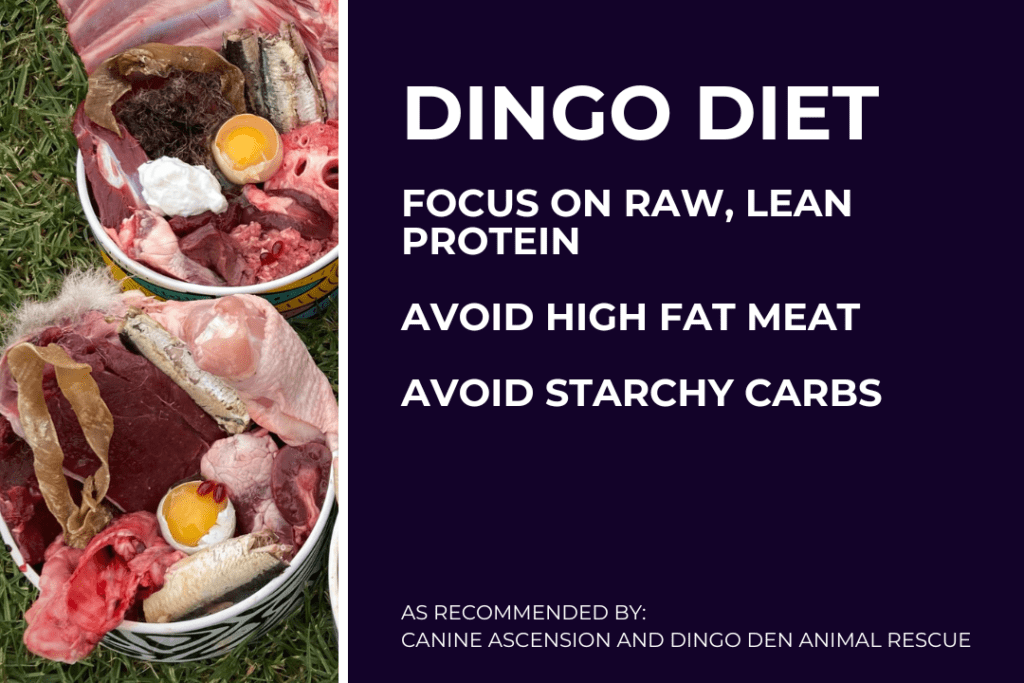
Dingo diets: The long story
Dingoes, like domestic dogs, are canines — however, dingoes are not dogs. Whatever you feed your kelpie or your golden, cannot necessarily be fed to your adopted dingo.
Dingoes must eat a high protein diet, low in fat and starchy carbohydrates. Canine Ascension states that dingoes cannot metabolise saturated or monounsaturated fats effectively, nor can they digest starchy carbohydrates such as flour, rice, potato, pumpkin, sweet potato and food that contains these ingredients, such as most commercial dog foods: “Dingoes fed high fat, high carb diets have half the life expectancy of a dingo fed a species-appropriate diet. They will also be more prone to bouts of pancreatitis and liver complications.”
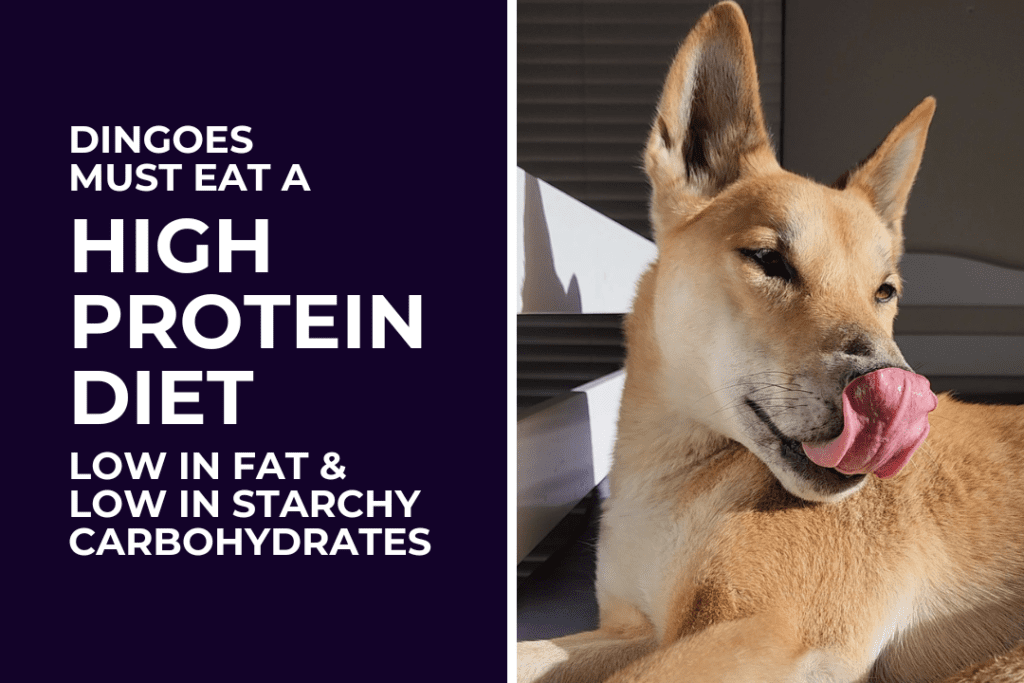
The benefits of feeding dingoes raw food
Feeding your dingo a raw meat diet will keep them happy today and help them live a longer, healthier life. They’ll have more energy and stamina, improved cognitive and motor skills and will be less likely to develop allergies, arthritis, cancer, kidney disease, and cardiovascular issues.
Your dingo’s coat will thrive, as well as their skin, nails and teeth. Canine Ascension also states that canines who are fed a primarily raw diet will produce less stool and will drink less water, since a raw diet is primarily 70% moisture while a dry-only diet is only 12% moisture. (Less poop patrol for you!)
Dingoes are naturally lean animals and focusing on a raw diet will help maintain a healthy weight.
Important considerations when feeding your adopted dingo:
- Feed primarily raw meat, not cooked
- Focus on protein and avoid fat and starchy carbohydrates
- Rotate options so your dingo has a varied diet
- Feed holistically, including meat, fur, feathers, head, feet and bones
- Understand where your dingo is from, for example, coastal dingoes are more likely to enjoy fish
- Consider following the Prey Model Raw (PMR) ratio of 80/10/10, as recommended by Canine Ascension and Dingo Den Animal Rescue. This ratio translates to 80% muscle meat, 10% digestible bones, 5% liver and 5% other organs.
- See this article for more detail, including which bones you must avoid.
Dingo Diet: What dingoes can eat daily
Each day, your dingo’s daily diet should be 80% lean meat, such as:
- Kangaroo
- Emu
- Rabbit
- Venison
- Goat
- Turkey
- Camel (not from desert regions)
Consider adding:
- liver (5% of total daily intake), and
- organs (5% of total daily intake).
The other 10% are bones, which are likely included in the lean meat above.
Note: Mince is okay but Canine Ascension states that intact muscle meats are a better option, “Mincing meat damages some amino acids, especially tryptophan which helps regulate behaviour (tryptophan deficiency is linked with aggressive and anxious behaviour). Feeding intact muscle meats ensures your dingo is getting the amino acids required for optimal health.”
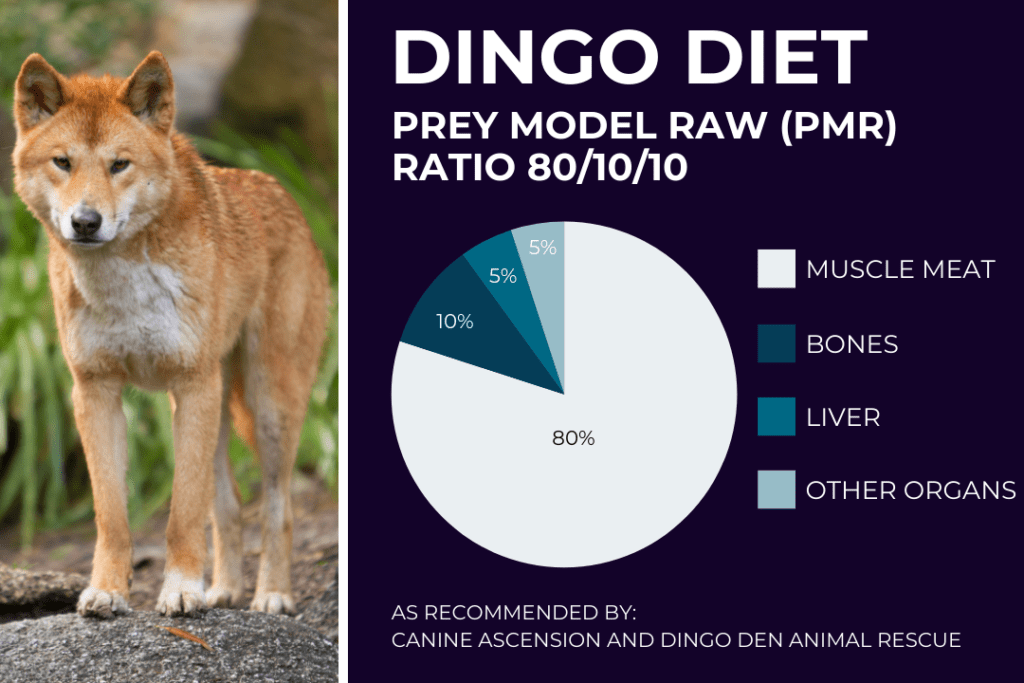
Dingo Diet: What dingoes can eat a few times a week
In addition to the lean meat above, consider adding or rotating any of the following:
- Lean beef
- Chicken
- Turkey
- Fish (1-4 times a week)
- Mussels (1-2 per meal, 3-4 times a week)
> See Dingo Diet Part 2 for more information about fish and mussels.
Dingo Diet: What to avoid
Avoid high fat cuts of meat and high fat meat such as:
- Lamb
- Pork
Avoid starchy carbohydrates:
- Carbohydrate-heavy vegetables (e.g. potato, sweet potato, pumpkin, corn)
- Grains (e.g. flour, rice)
Dingoes cannot process starchy carbohydrates. See this article for important information about kibble.
Dingo Diet: Do not feed the following to your dingo
- Live animals
- Cooked bones
- Weight bearing bones from large animals
It’s also important to avoid rendered meats and fats (the base of dry dog food).
Source: Canine Ascension and Dingo Den Animal Rescue.
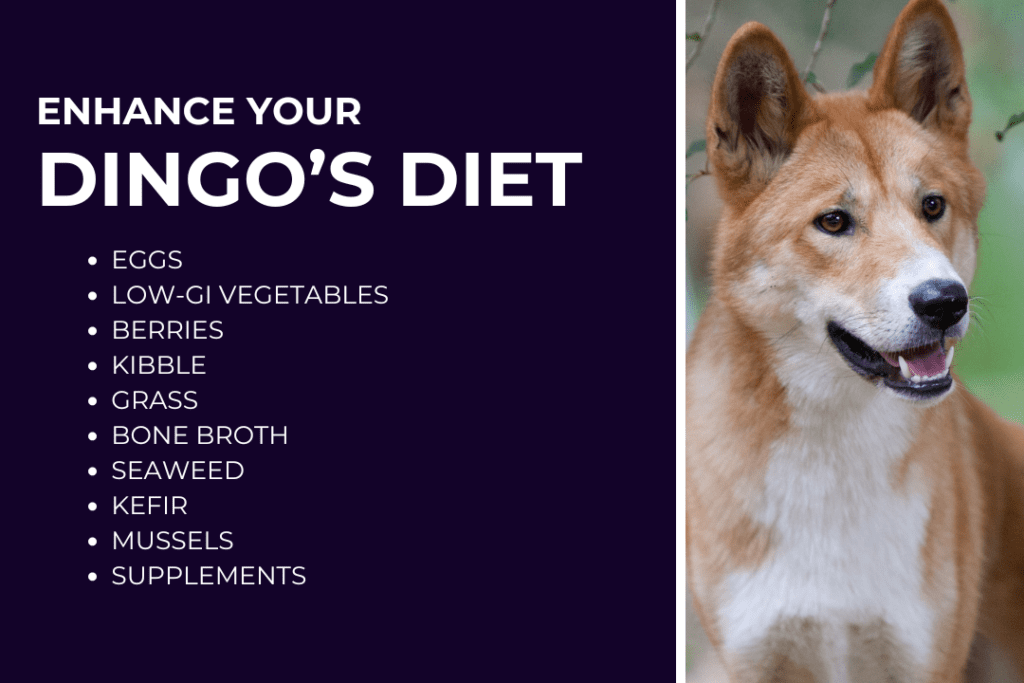
How to enhance your dingo’s diet
Consider adding small amounts of the following, on occasion:
1. Eggs
- Dingoes can eat eggs from chickens, ducks and geese
- It’s okay to feed your dingo the eggshell
- Give your dingo 1-2 eggs about twice a week
- Don’t give eggs too often due to the fat content
- Canine Ascension recommends avoiding duck and goose eggs if your dingo is susceptible to pancreatitis or fatty liver
- Find more info about eggs at Dingo Den Animal Rescue.
2. Pureed, steamed or fermented low-GI vegetables such as leafy greens
- Avoid starchy carbohydrate vegetables such as potato, sweet potato, pumpkin, corn
- Opt for greens such as celery, cucumber, spinach, broccoli, bok choy, cabbage, kale and asparagus
- Canine Ascension states that dingoes “don’t have the jaw structure, teeth or intestinal tract to break down whole vegetables”, so it’s important to prepare your dingo’s vegies
- Puree, lightly steam or ferment (see Dingo Diet Part 2 for more info)
- Canine Ascension notes that cruciferous vegies should be avoided if your dingo has thyroid or kidney issues.
3. Berries
- Dingoes can eat 4-8 berries, a few times a week — if they like them!
- Choose fresh, frozen or pureed berries
- Do not feed dried berries (sugar content is higher)
- Consider blueberries, blackberries, raspberries, cranberries, mulberries
- Goji berries can be fed very sparingly
- Do not feed your dingo cherries, juniper berries, holly berries, mistletoe berries, baneberries.
4. Kibble
- A raw meat diet is ideal however kibble can be fed to your dingo in limited quantities
- Choose a kibble that is high protein, low fat and low in starchy carbohydrates
- Please read FAQs about dingo diets for important information about kibble.
5. Grass
- Dingoes consume wild grass as part of their natural diet.
6. Bone broth
- Consider making your own bone broth
- Serve in liquid form or as gelatin
- If using gelatin, use 100% gelatin only, with no sweeteners, colours or flavours.
7. Seaweed
- Consider organic seaweed powders or flakes (kelp or dulse)
- Avoid wakame and kombu
- Be careful how much seaweed you serve your dingo. It’s important to read this post before giving your dingo seaweed.
- Choose products which have been tested for heavy metals
- Seaweed contains iodine and trace minerals which help maintain a healthy coat and prevent plaque.
8. Kefir
- Kefir is fermented milk. Canine Ascension recommends using goat’s milk
- It’s a good source of probiotics
- Make your own kefir
- Make your own cottage cheese.
9. Mussels
- 1-2 per meal, 3-4 times a week
- See Dingo Diets Part 2 for important information about preparing mussels for your dingo.
10. Supplements
- Consider adding supplements to your dingo’s diet, under the guidance of an expert.
- Supplements include Australian cricket powder, Antinol, MSM powder, Immunol, astaxanthin, blue spirulina and vitamin C. Most of these are specific to certain health issues or wild-born orphans. General supplements required more frequently are Vitamin E, manganese, magnesium, iodine, zinc.
- For more information visit Perfectly Rawsome. Please note Perfectly Rawsome is a nutrition resource for domestic dogs and not all recommendations will be dingo-friendly.
Next in this series is “Dingo diet: 10 frequently asked questions about dingo diets.“
Adopting a dingo is no small feat, it can be very overwhelming at the start, so I hope this guide is helpful for you and your dingo. Big thanks to Gabriele at Canine Ascension for sharing her valuable knowledge.
More information about feeding your dingo
Canine Ascension offers excellent guides to feeding Australian dingoes. Many of the links have been included above.
More dingo guides by Canine Ascension:
- Transitioning to a raw diet
- Feeding dingo hybrids
- Managing diarrhoea in dingoes
- Tori’s diet (dingo hybrid)
- Dingo Christmas pudding recipe
- Halloween brains
- Stuffed chicken frames

Canine Ascension’s seasonal dingo feeding guides:
- Spring
- Start decreasing the amount of food you serve
- Adult dingoes might refuse food
- Support skin and coat shedding (kangaroo, fish, eggs, oysters, liver, soaked and pureed sunflower seeds, dingo-friendly oils)
- Summer
- Dingoes might eat less in summer
- Decrease greens, add fruit occasionally
- Provide more electrolytes in hot weather (seaweed, pureed celery, cucumber, pure coconut water, bone broth, natural/Greek yoghurt from goat’s milk, digestible bones, mussels, fruit)
- Autumn
- Increase meal size
- Food refusal may happen
- Add more fish and greens to support new coat growth
- Winter
- Feed more food (but not more liver)
- Consider warming meals with warm bone broth, turmeric gravy, dingo friendly herbal tea or thaw their food to room temperature
- More oily fish for tropical dingoes
- More pureed leafy greens
- Less fruit
- For alpine dingoes, slightly increase fats (up to 12% of diet)
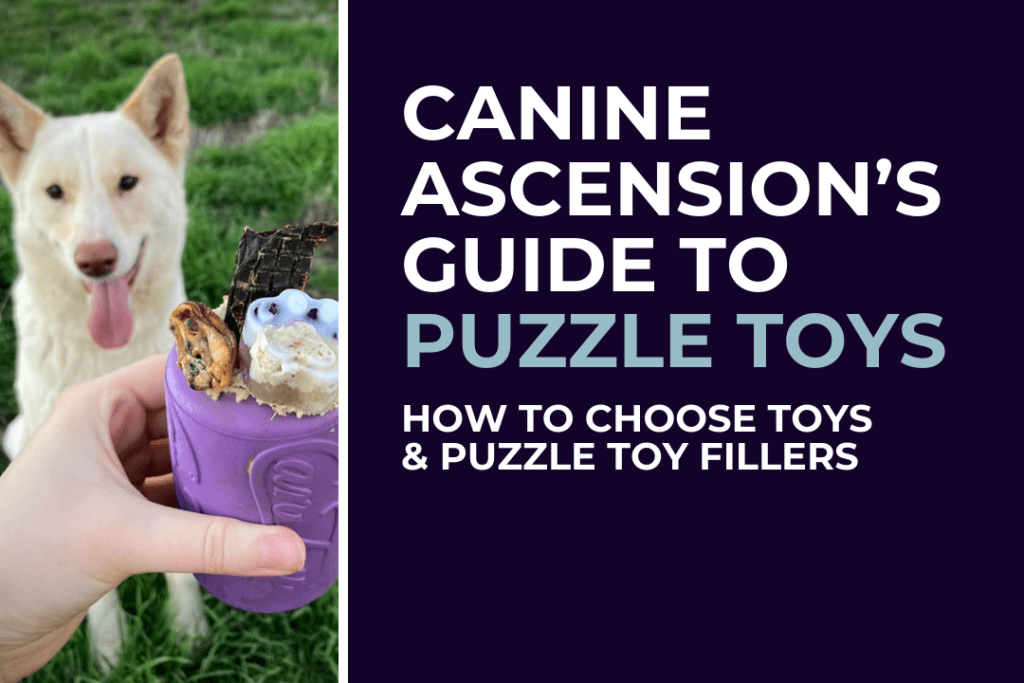
Canine Ascension’s guide to puzzle toys:
Puzzle toys can be a great way to engage your dingo, tire them out and provide mental stimulation — this is also known as canine enrichment. These are particularly useful when it’s raining or when you need to keep your dingoes busy, such as dawn and dusk, or when the aeroplanes are flying overhead!
- Serve fresh or frozen (some toys should not be frozen)
- To prevent injury, never fill the safety hole when freezing enrichment toys
- Avoid leaving your dingo unsupervised with enrichment toys
- Check enrichment toys regularly for wear and tear
Choosing puzzle toys:
Dingoes have a very strong bite force, which means you need to look for strong, durable enrichment toys.
- What to look for and the Magnum by SodaPup
- Starmark Everlasting Tetraflex and treatballs
- West Paw Tux Zogoflex or Toppl
- Kong Extreme Large or XL
- Kong Quest Wishbone
- AussieDog
- Rover Pet Products Lifesaver and Gear
- JW Penguin
- SodaPup LifeSaver, Turkey, Dice, Coffee Cup
Puzzle toys fillers
Here’s a great list of fillers for your dingo’s enrichment toy.
- Poultry Puzzle Stuffer recipe
- Sardines and more
- Flavoured ice
- Mixed recipes
- Examples of fillers:
- Sardines
- Mussels
- Tripe
- Bone broth
- Green lipped mussels
- Octopus
- Shark cartilage sprinkles
- Raw turkey or chicken
- Nori sheets (shredded)
- Goat mince
- Eggs (raw or cooked)
- Fermented cottage cheese (AKA quark)
- Sunflower seeds (soaked, rinsed, pureed)
- Dried training treats listed above
>>> Next in this series is “Dingo diet: 10 frequently asked questions about dingo diets”.
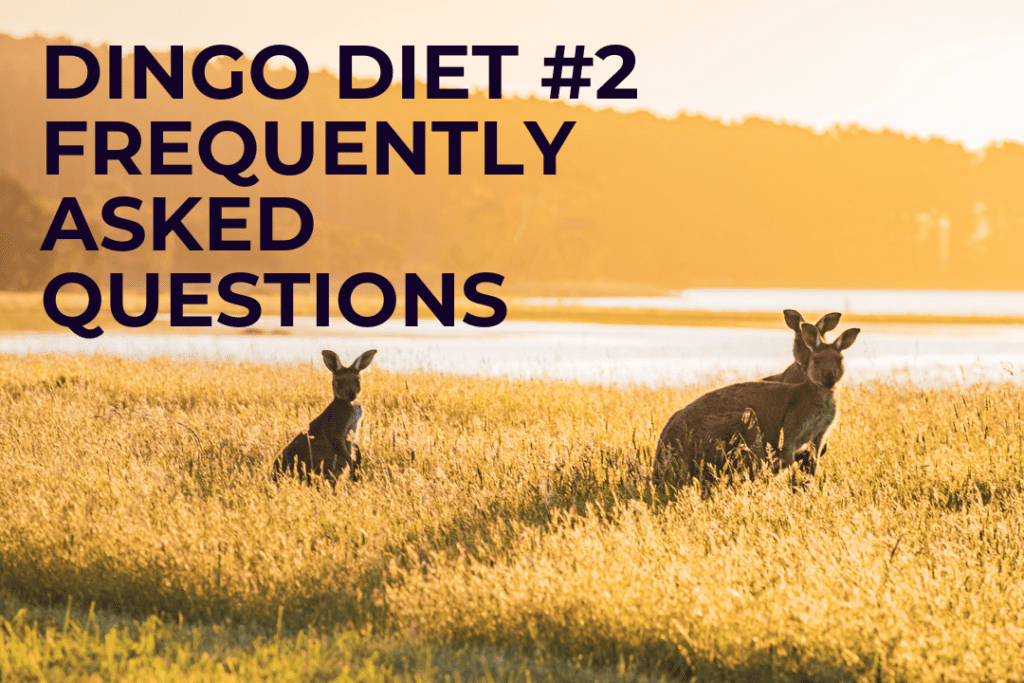
NOTE: This article is general in nature and is for information purposes only. It is not a substitute for specific qualified advice that considers your or your dingo’s specific circumstances.
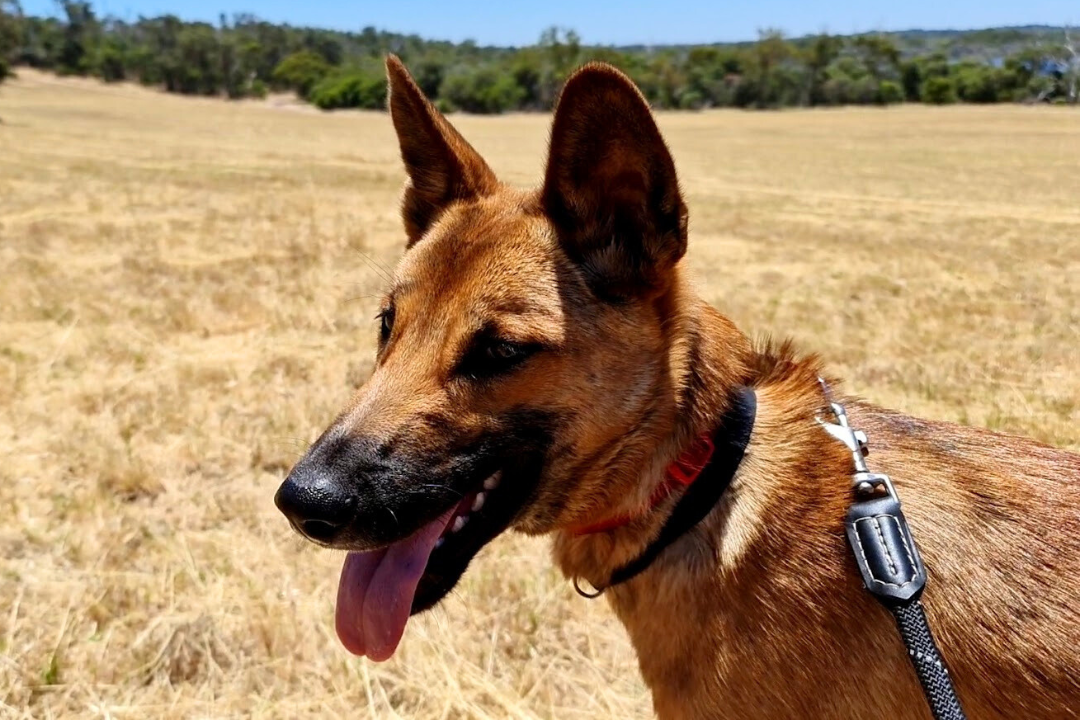
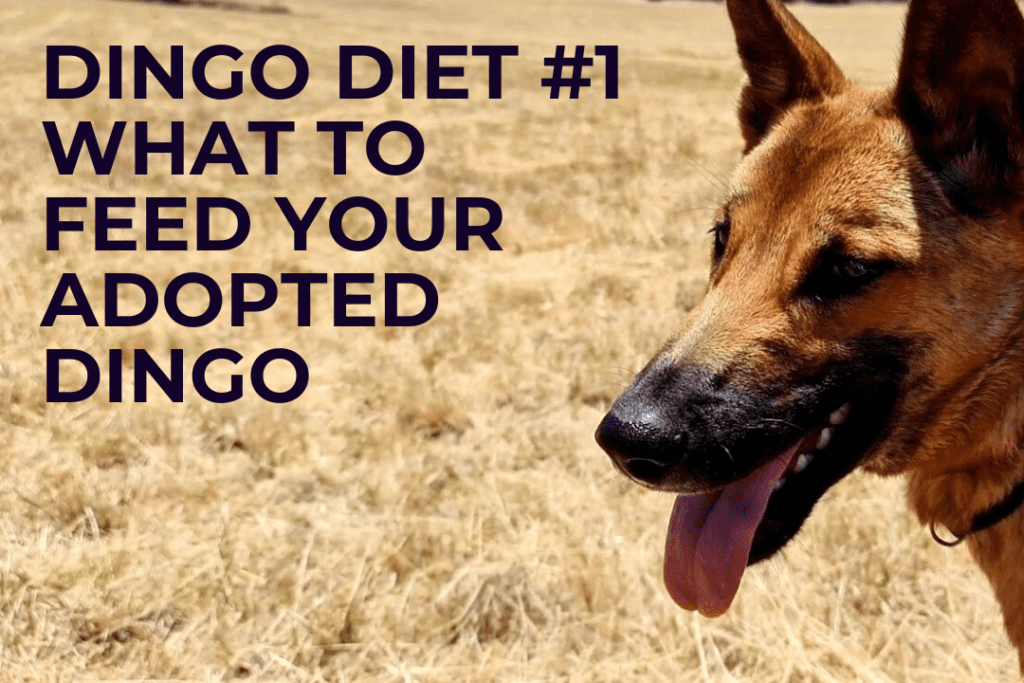
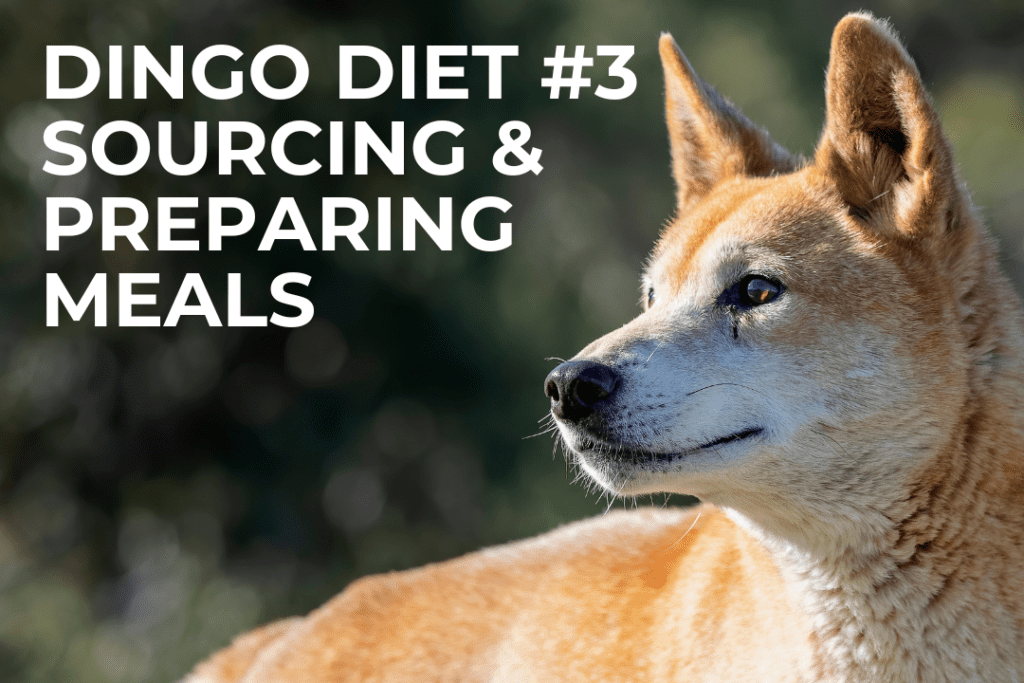
Thank you for your article. What a blessing! We have a genetic anomaly, aka Unkoso the misfit Red Healer. It took nearly a year to understand that he is a Dingo. We live in the US,and little is known about them,especially feeding. Unkoso is 13 and in good health, but we are concerned about his diet. While you address the what and how, I’ve not seen, as yet, about how much. (Maybe I just missed it.) Please keep your keep your info coming. Vets treat Koso like an odd dog, so any information in that area would be most helpful.
Hi Linda!
Unkoso is such a unique name – do you pronounce it “oon-koh-so”? I’ve heard of American Dingoes AKA Carolina Dogs, but I’m not familiar with what they eat. With Australian dingoes, Canine Ascension recommends 2-3% of a dingo’s ideal adult weight and then adjusting from there. I’ve included this in the 3rd article about dingo diets dingo diet series.
Adult Australian dingoes can weigh anything from 13kg to about 23kg. Rusty was about 20kg at his last vet visit, so we feed them about 500g of raw protein a day, plus they get an extra treat like a Likimat. We’re quite mindful about how much we feed our dingoes — when they’re full, Australian dingoes tend to hide the extra food for later. They dig a hole and bury it with their nose. With two dingoes, this can cause resource guarding, so they’re never allowed to keep leftovers…. but if for some reason Rusty is still hungry later, he’s pretty vocal about it. I think this has only happened twice and he was easily pleased with an egg.